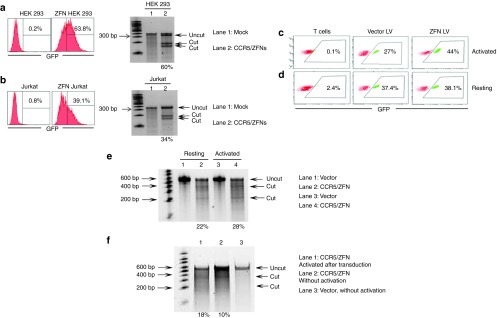Figure 1.

ZFN-expressing NILV-mediated disruption of CCR5 gene in cell lines and primary human CD4+ T cells. (a) Transduction efficiency and CCR5 disruption efficiency of HEK 293 cells. HEK 293 cells were transduced with CCR/ZFNs NILV pseudotyped with VSV-G at an MOI of 30 and examined for ZsGreen expression by flow cytometry after 48 hours. The genomic DNA extracted from the transduced cells was tested for CCR5 disruption by T7 endonuclease assay using a Tris-Acetate PAGE gel. Empty vector (GFP only) was used as control. (b) Transduction efficiency and CCR5 disruption efficiency in Jurkat cells after ZFN delivery with HIV envelope pseudotyped NILV. (c) PHA-activated CD4+ T cells were transduced with CCR5/ZFN NILV pseudotyped with HIV envelope at an MOI of 30 and ZsGreen-positive cells were enumerated by flow cytometry. (d) Resting CD4+ T cells were transduced as in c, and then activated with PHA 4 hours after transduction. For both activated and resting CD4+ T cells transduction assays, the empty NILV (without CCR5/ZFN) was used as control. (e) The frequency of CCR5 disruption in activated and resting CD4+ T cells (activated 4 hours after transduction) was assessed by T7 endonuclease assay. (f) The frequency of ZFN-mediated CCR5 disruption in resting CD4+ T cells with or without activation after transduction. Purified resting CD4+ T cells were transduced with NILV at an MOI of 15. The frequency of CCR5 disruption assessed by T7 nuclease assay is indicated as percentage of total population, calculated by the formula: 100 × [1 − (1 − fraction of cleavage)1/2]. Representative data from experiments performed at least three times are shown.
